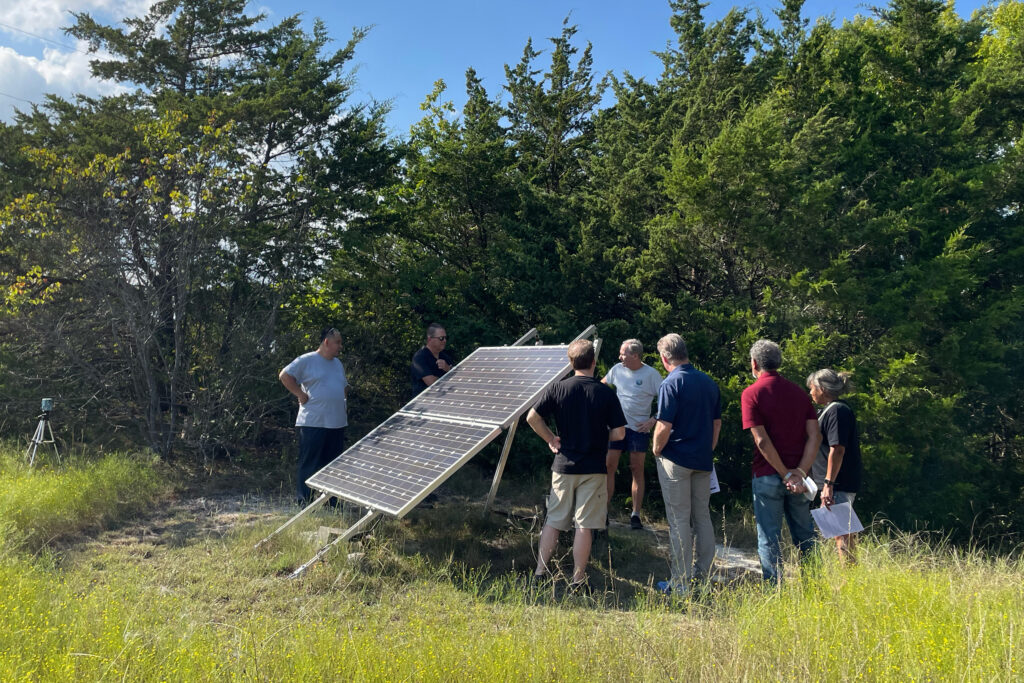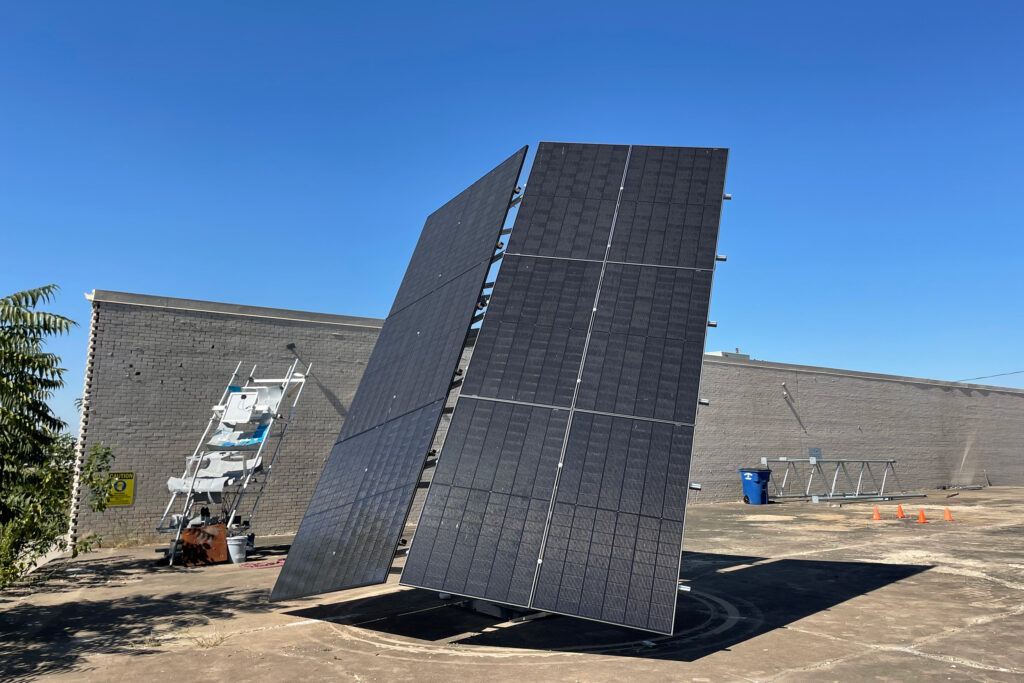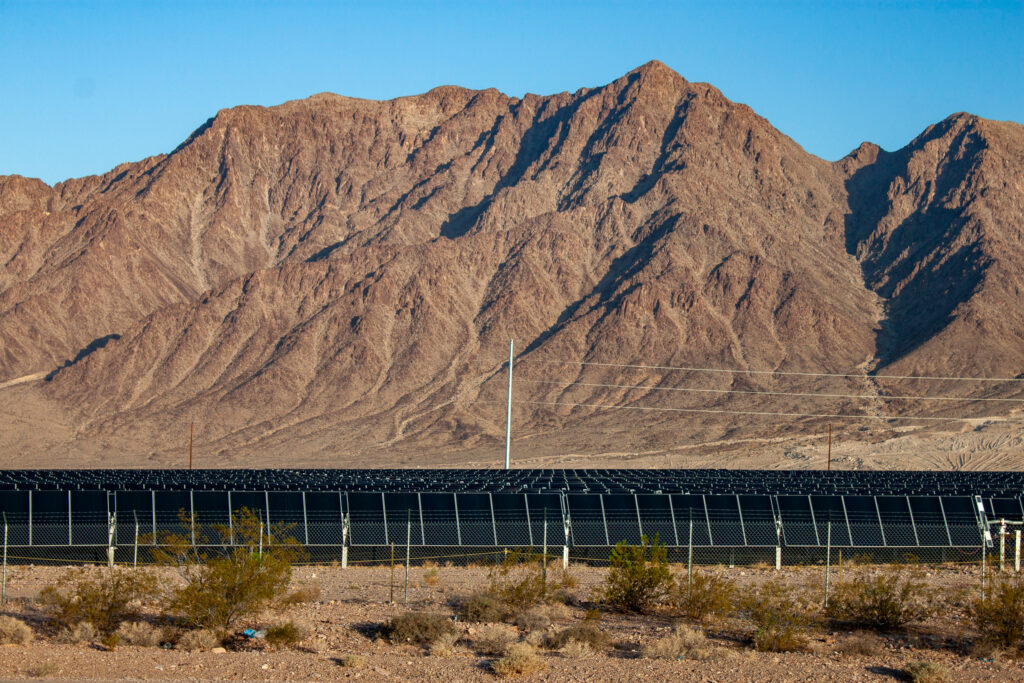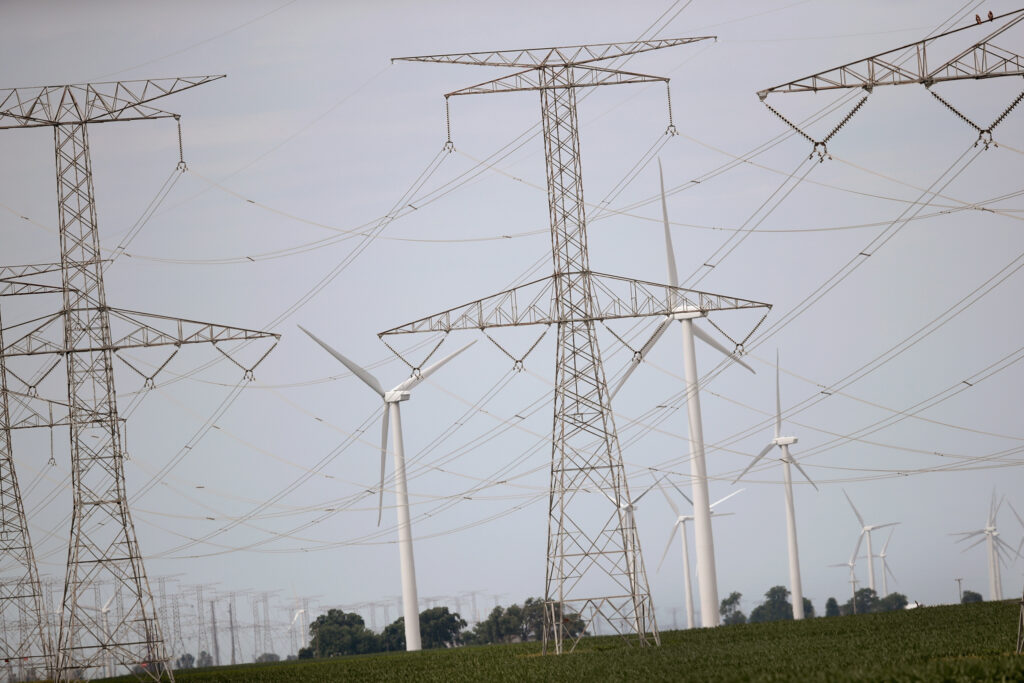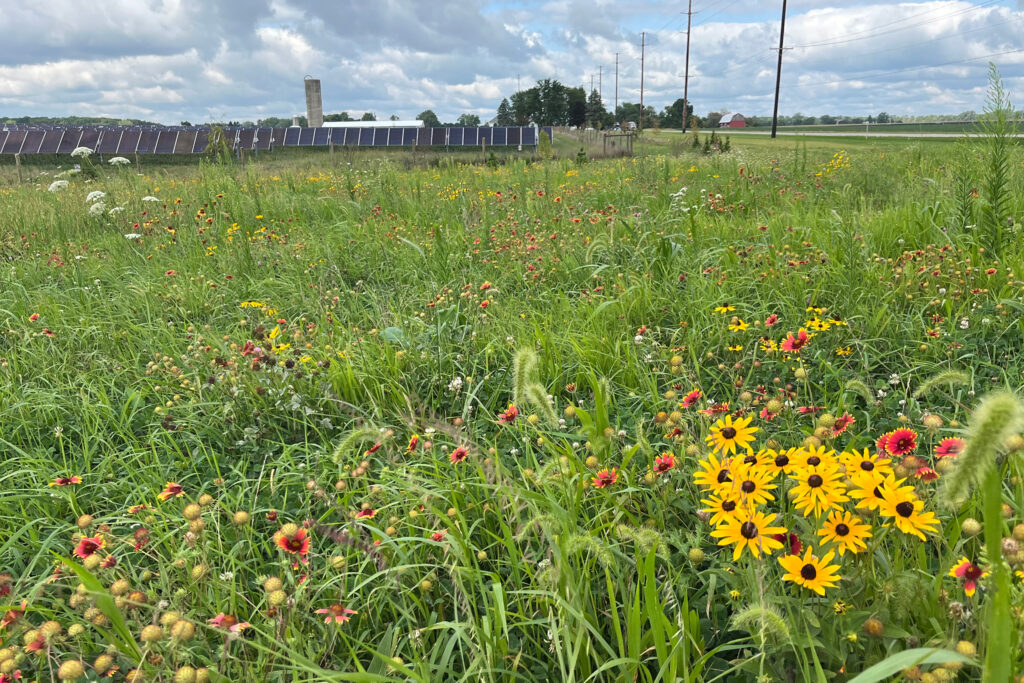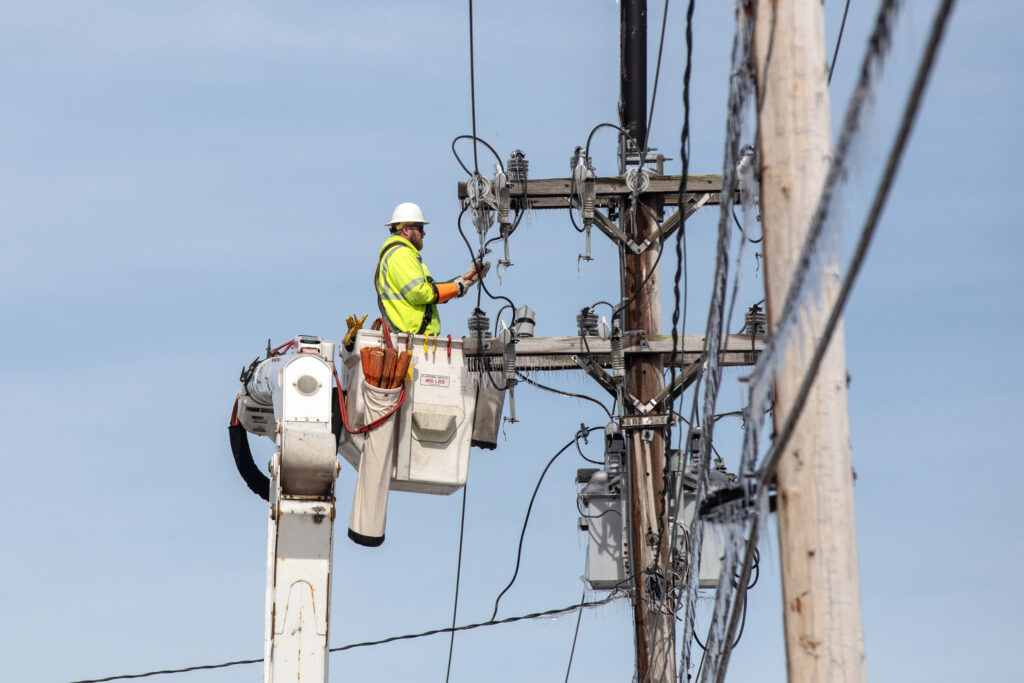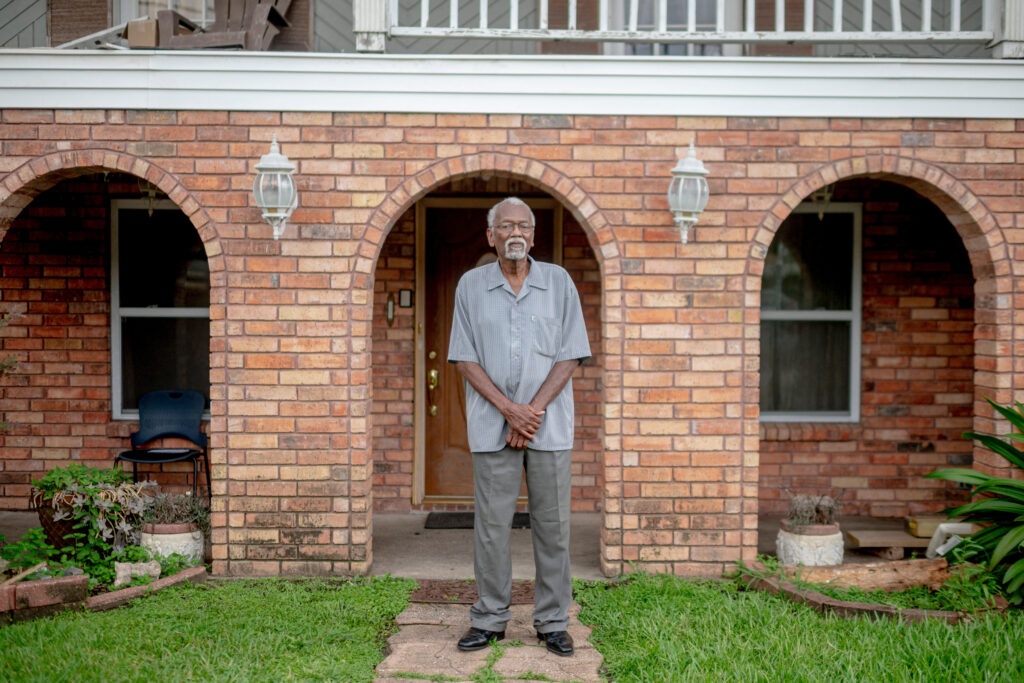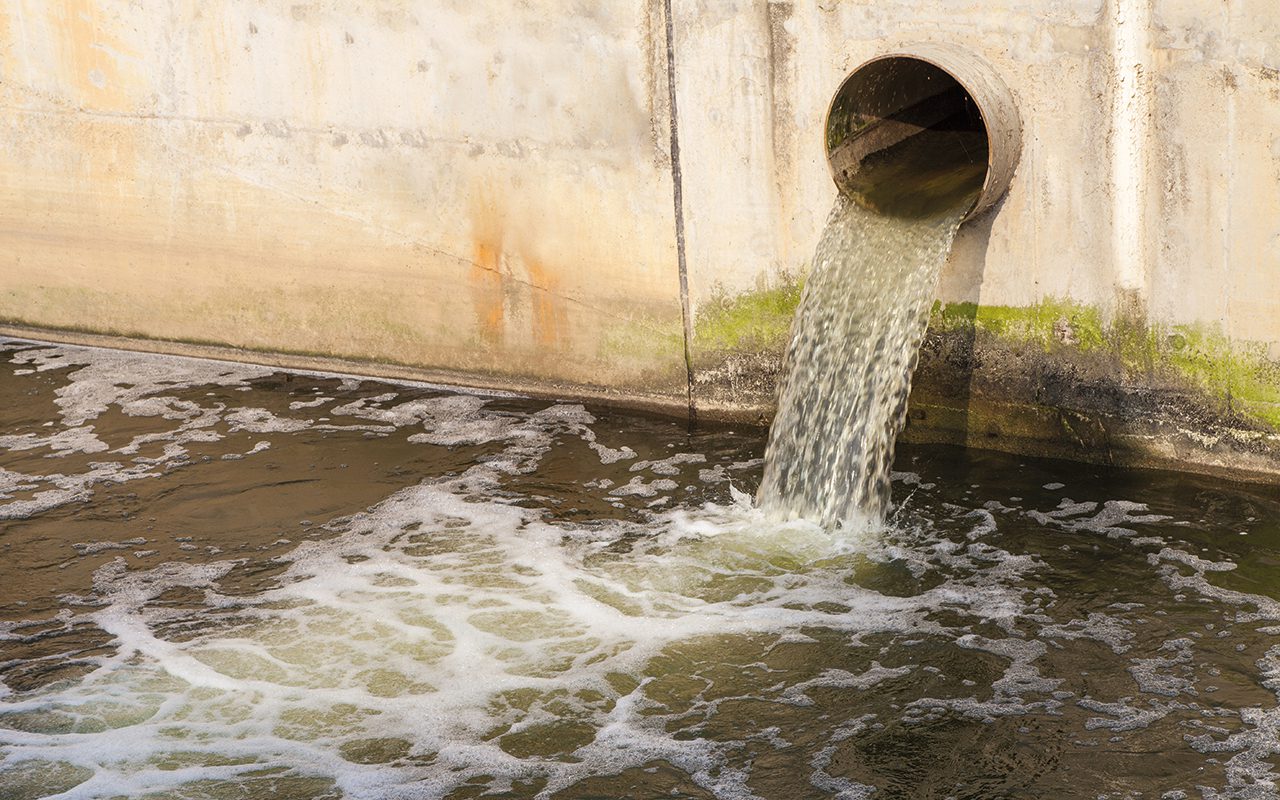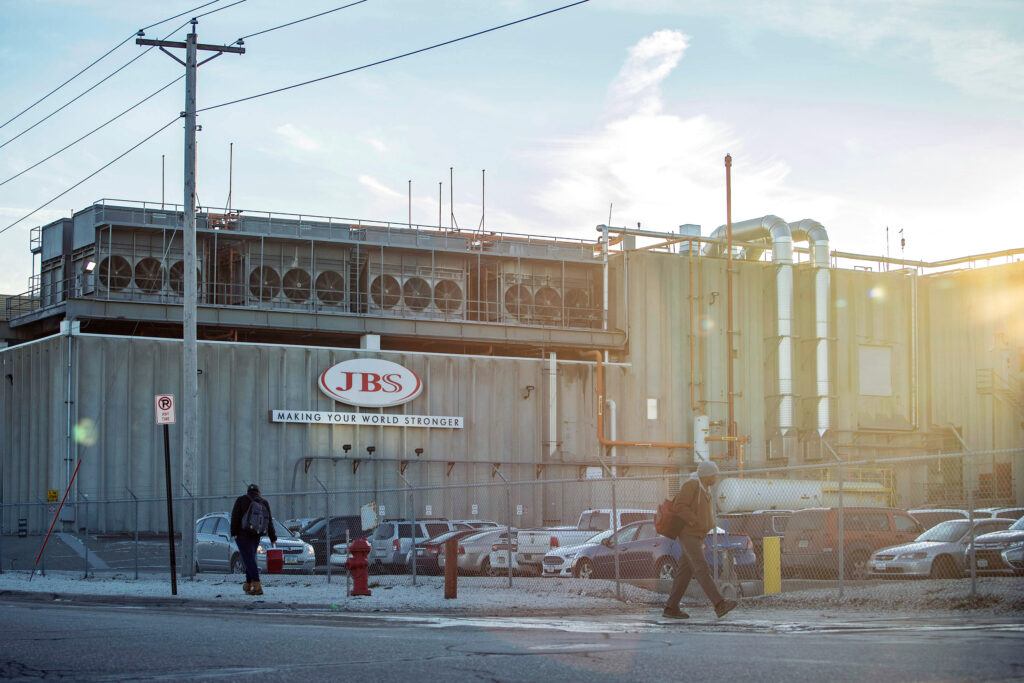The noise of hammers and saws was so loud that David de Leon stepped outside of the house where he was working, so he could talk and be heard.
De Leon is construction manager for Bridge of Grace Compassionate Ministries Center in Fort Wayne, Indiana, a faith-based nonprofit and one of hundreds of organizations across the country that until recently stood to benefit from President Joe Biden’s effort to catalyze a clean energy transition.
Now, Bridge of Grace is among the groups at the losing end of the chokehold that President Donald Trump’s administration has put on that plan. Trump’s Environmental Protection Agency in mid-February placed an extraordinary freeze on one of the largest climate programs in the 2022 Inflation Reduction Act, the $27 billion Greenhouse Gas Reduction Fund. A federal court is now weighing whether that action defied EPA’s contractual obligations, several laws and the grantees’ Constitutional rights to due process of law, with the next hearing in the case set for Wednesday.
We’re hiring!
Please take a look at the new openings in our newsroom.
See jobs
The fight in Washington threatens to slow Bridge of Grace’s plans to expand its work buying and rehabilitating dilapidated houses in Fort Wayne. The group aims to reduce blight, provide much-needed housing for low-income families and cut energy consumption and costs with efficiency and appliance upgrades. And yet, de Leon remains optimistic that some good can still come of this.
“I put everything in God’s hands,” he said. “If it doesn’t happen, you know, something else, bigger and better, will come out.”
But the wait for a program like this one already had been long.
Climate activists had advocated for nearly two decades for a “green bank” that would use federal money to spur private investment in the clean energy transition. Low-interest loans could spur homes and businesses to adopt renewable energy and efficiency upgrades, especially in disadvantaged areas. This idea became law in 2022, but it has now run into the buzzsaw of Trump administration budget cuts and attempts to do away with Biden-era climate programs, sending shockwaves across the country to local governments, lenders, developers, small businesses and others that were counting on having access to these loans.
Participants saw in the program an opportunity for the government to boost local economies while improving the environment and saving money. The Trump administration characterized it as a giveaway—potentially, a criminal one—that was part of a harmful green agenda. Trump’s team also is using the fight over the climate fund to assert an expansive view of executive power—arguing that any federal contracts can be brushed aside based on a change in policy priorities by a new administration.
“The days of irresponsibly shoveling boat loads of cash to far-left, activist groups in the name of environmental justice and climate equity are over,” said Lee Zeldin, administrator of the EPA under Trump.
An EPA spokesperson declined to comment, saying the matter is in litigation and the agency has laid out its case in court filings.
“A Smarter, More Efficient Way”
The Greenhouse Gas Reduction Fund was unlike any other of the thousands of environmental grants that the Biden administration awarded under the 2021 Infrastructure Investment and Jobs Act and the 2022 Inflation Reduction Act. It was not meant to be a government handout, but rather seed money to get private lenders to finance the clean energy transition at the ground level.
Climate policy thinkers began talking about the concept nearly 20 years ago. Government couldn’t fund a clean energy transition all on its own, they reasoned. Instead, government could assume some of the risk and provide guidance that would spur private lenders to begin making the kind of loans they weren’t making—for energy-efficiency and renewable energy projects for homes and small businesses, especially in low-income communities that needed the most help.
“It was designed to address sort of market failures in certain areas, especially low-income neighborhoods where generating a transition to clean energy and energy efficiency can both reduce bills and address the climate crisis by reducing emissions,” said U.S. Sen. Chris Van Hollen (D-Md.) in a recent interview. He introduced one of the first green bank proposals in Congress in 2009, when he was still a member of the House.

It was one of the only ideas to garner bipartisan support in a committee vote that year as Congress debated President Barack Obama’s ill-fated climate legislation, co-sponsored by current Sen. Ed Markey (D-Mass.), then a representative. The big bill, which would have capped U.S. greenhouse gas emissions and employed a market-based trading system to drive investment, died in the Senate.
In 2011, Sen. Lisa Murkowski (R-Alaska) picked up the green bank idea, working on a bill with former Sen. Jeff Bingaman (D-N.M.), then chair of the Senate Energy Committee, who saw it as one of the only climate solutions that could get GOP support. Said Murkowski, “It’s a smarter, more efficient way for the federal government to promote clean energy technologies.”
As it turned out, Congress would not take up climate legislation again for more than a decade. But in the meantime, the green bank idea took off in states and around the world. Connecticut’s state legislature paved the way for the nation’s first green bank by bipartisan vote in 2011, and since then 20 more public and quasi-public green banks have been established from Hawaii to Rhode Island, including in red states like Texas, Missouri and South Carolina.
Green banks have been established in the United Kingdom, Japan, Australia and other countries. The Natural Resources Defense Council calculates that such banks have funded $143 billion in clean energy projects that have cut climate-damaging emissions equivalent to taking 25 million gasoline cars off the road.
A key feature of green banks is their multiplier effect. Public money is meant to act as a backstop that gives private lenders, mostly credit unions and small community banks, the confidence to lend larger sums to get climate-friendly projects done. Such lenders are accustomed to financing home mortgages and auto loans, not clean energy.
“Financing in clean energy, energy efficiency, solar and so forth is a very specialized market,” said Bert Hunter, executive vice president and chief investment officer of the Connecticut Green Bank, who sees its job as providing “a pathway for local lenders to get acquainted with this market.”
Since its inception 13 years ago, private lenders have put $7 into clean energy projects for every $1 loaned by the Connecticut Green Bank—for a total of $2.9 billion. The money has financed energy upgrades for more than 63,000 Connecticut families and 8,000 businesses. Delinquency rates have been low or on par with national averages for mortgage and auto loans, even though 32 percent of the lending has been in low-income and disadvantaged communities, which have fewer resources.
Van Hollen says the combined economic and environmental benefits, plus reduced reliance on foreign oil, make green banks a “win-win-win” public policy. “This is a case where it needed some government incentive to make these necessary changes and to move in the direction of more clean energy, more energy efficiency,” he said. When the opportunity finally came in 2022 to advance climate legislation in Congress, Van Hollen and Markey worked with the Biden administration to make sure that the Inflation Reduction Act included a provision for a green bank, now called the Greenhouse Gas Reduction Fund.
Because the IRA was a budget reconciliation bill—a special type of legislation that requires only a simple majority for Senate passage—it had to be designed as a grant program. But the $27 billion wouldn’t be spent and gone as with the other grants. The recipients would work in partnership with private lenders to generate loans to be paid back with interest, with the proceeds reinvested in more clean energy projects over time.
Supporters of the fund point to evidence that it was working, even in its earliest stages. One of the main recipients, the Coalition for Green Capital, had already closed six clean energy projects totaling $33.7 million by the end of 2024, according to court testimony. Those deals attracted $192 million in private investment; every $1 of federal money was mobilizing $6 of private capital. The coalition told the court it received many more proposals and was considering funding 24 that would have deployed a combined $16 in private financing for every $1 of financing by the federal government.
But this work, an estimated $85 billion in clean energy projects, is now on hold, blocked by the Trump administration’s attempt to radically reconfigure the congressionally approved fund.


Frozen Accounts at Citibank
The Trump administration has sought to slash government spending across the board, but its attack on the Greenhouse Gas Reduction Fund has been on a different level.
Trump and his team didn’t just seek to claw back $20 billion of the awarded money; they launched a criminal investigation into the program. They notified grantees that their contracts were terminated “based on substantial concerns regarding program integrity, the award process, programmatic fraud, waste, and abuse, and misalignment with the Agency’s priorities, which collectively undermine the fundamental goals and statutory objectives of the award.”
Zeldin targeted three-quarters of the Greenhouse Gas Reduction Fund, including the entirety of two programs, the National Clean Investment Fund, designed to help finance low- and zero-emissions energy projects, more than half of them in low-income and disadvantaged communities, and the Clean Communities Investment Accelerator, which works with community-based lenders to finance such projects for individuals and small businesses, all of them in disadvantaged areas.


“I will not rest until these hard-earned taxpayer dollars are returned to the U.S. Treasury,” Zeldin said in a press statement.
In EPA’s latest court briefs, however, the agency spends less time on allegations of wrongdoing, although it does say the criminal investigation is ongoing. The agency spends more time on its authority under law, claiming that it has the right to break contracts if its priorities change.
The Trump administration argues that grant recipients may be able to pursue a claim in the U.S. Court of Federal Claims (where the only relief would be monetary), but it can not be forced “to proceed with billions of dollars in grants that it has decided no longer advance the interests of the United States.”
The shift in the arguments comes after the grantees challenged many of the Trump EPA’s arguments:
- Zeldin’s office accused a Biden administration official of steering one of the grants to his former employer. But that official had recused himself from funding decisions on the program; his recusal letter was filed in court as evidence by the grantee in question, which noted the evidence had been “readily available” to EPA.
- Trump, in his March 6 address to Congress, decried the Biden administration for granting Greenhouse Gas Reduction Fund money to a group “headed up” by two-time Democratic Georgia gubernatorial candidate Stacey Abrams. But Abrams formerly played only a side role, as a counselor, to one nonprofit, Rewiring America, that was part of a larger coalition, Power Forward Communities, which included other large nonprofits like Habitat for Humanity and United Way. The groups planned to finance large-scale home decarbonization, and no money was going to Abrams.
- Zeldin has portrayed the grants and the Biden administration’s use of an outside financial agent to hold the funds, Citibank, as “purposefully designed to obligate all of the money in a rush job with reduced oversight.” But the awards were announced last April and the contracts were signed last August, before the election, since Congress set a deadline in the law for launch of the program by September 2024.
U.S. District Judge Tanya Chutkan concluded that so far the Trump administration has “proffered no evidence to support their basis for the sudden terminations” of the contracts. On March 18, she blocked the EPA from taking back the money, but did not free it up for the grantees. It is now sitting in the accounts at Citibank while the litigation proceeds.
“They’re just manufacturing claims, and that manufacturing of claims is itself a fraud. It’s a fraud on the public.”
— U.S. Sen. Chris Van Hollen (D-Md.)
This program represents the first time EPA, which had never before administered such a large grant initiative, has used an outside financial agent like Citibank. But such agreements have been used often by the federal government to handle large transactions, including to transmit assistance to businesses during the COVID-19 pandemic.
The arrangement “increased transactional visibility” for EPA and was designed specifically to give the agency a security interest in the money—a legal right to the funds if the grant recipient had not performed its contractual duties, an official of the Coalition for Green Capital told the court. Such an arrangement was not possible through the government’s in-house government grant distribution system.
Indeed, one portion of the fund—the $7 billion Solar for All program—is not being held up but is being administered to 60 grantees nationwide through the government’s grant distribution system. The Trump administration froze this money for a time, but released it amid continuing court battles over its latitude to block congressionally approved grant programs.
In Van Hollen’s view, the use of Citibank as an outside financial agent got under the skin of Trump administration officials in their effort to assert control at all levels of government.
“I believe they’re frustrated because the Biden administration was able to place these funds beyond their clawback reach,” Van Hollen said. “So they’re just manufacturing claims, and that manufacturing of claims is itself a fraud. It’s a fraud on the public.”
A Hidden Camera, a Prosecutor’s Resignation
The Trump administration’s attacks on the Greenhouse Gas Reduction Fund program are an extension of a fight that right-wing foes have been waging against the program since its inception. When winners of the fund’s grants were first announced on April 4, 2024, by Vice President Kamala Harris in a visit to North Carolina, conservative commentator Ben Shapiro, whose YouTube channel has more than 7 million subscribers, posted a segment mocking Harris’ speaking mannerisms and ridiculing the planned central role of community banks (“so wildly profitable compared to the big banks,” he said, sardonically).
The day before the November election, House Republicans posted a report decrying the Biden-Harris administration’s environmental justice grants as a “green group giveaway.” They singled out Power Forward Communities, a new coalition that had been awarded $2 billion from the federal fund for financing home energy efficiency upgrades at scale. The report said the administration “financially rewarded another organization espousing its same policy views.”
On Dec. 3, the right-wing group Project Veritas, which specializes in hidden camera recordings to attack political opponents, posted a video of a young EPA staffer, Brent Efron, apparently captured in a social setting, describing colorfully how the Biden administration was getting grant money out the door before Trump’s inauguration. “It truly feels like we’re on the Titanic … throwing gold bars off the edge,” he said in the video.
But Efron’s lawyer, Mark Zaid, has said his client was not referring to the Greenhouse Gas Reduction Fund. Efron only joined the EPA last July, according to his LinkedIn profile, and was still in graduate school when the grant awards were announced last April.
Nevertheless, Zeldin has adopted “gold bars” as his mantra in a drive to seize the money. He cited the Project Veritas video on Feb. 12 when he first announced he was referring the matter to U.S. Department of Justice investigators. His office again cited the video in a March 2 letter to the EPA’s Office of Inspector General, the first detailed public accounting of the Trump administration’s case against the program.
It has been a stunning reversal of fortune and elevation in status for Project Veritas, which over the years has gotten a portion of its funding from fossil fuel industry allies. Project Veritas had been under criminal investigation for paying $40,000 to two Florida residents who had pleaded guilty to stealing the diary of Biden’s daughter in an effort to embarrass him.
Within two weeks of Trump’s inauguration, though, the Justice Department announced it would not bring charges against Project Veritas. And the next week, Zeldin cited the group’s covert recording as the basis for the Trump administration’s own criminal investigation.
That probe got off to a rocky start. Denise Cheung, the head of the criminal division in the U.S. attorney’s office in Washington, D.C., a 24-year veteran of the department, handed in her resignation after she was ordered to freeze the Citibank accounts and issue subpoenas.
According to her resignation letter, made public by The Washington Post, she told Trump administration officials she had no legal authority to order such a freeze and her team concluded the evidence, including the Project Veritas video, did not meet the threshold for opening a grand jury investigation.
The case was then taken up personally by the Trump-appointed interim U.S. attorney for the District of Columbia, Ed Martin, a longtime conservative activist who called the federal program “insanity” and “total graft” in a post on X in October.
But a U.S. magistrate judge in D.C. rejected Martin’s application for a seizure warrant, and the Justice Department transferred the probe to Florida. “This chain of events provides abundant reason to believe that the Trump administration is purposefully misusing the tools of law enforcement, and pursuing false allegations of criminal conduct,” wrote Sen. Sheldon Whitehouse (D-R.I.) in one of several queries Democratic senators have sent to administration officials.
A hearing in the lawsuit brought by grantees was originally scheduled for March 11, but the Trump administration asked for a 24-hour delay, which it used to send termination notices to all the grant recipients. The following day, it asked the court to dismiss the case because, among other things, the grants had been terminated and the case was moot.
But the judge did not buy it, saying EPA’s unilateral cancellation of the grants meant the grantees were even more within their rights to sue. Even if EPA has valid concerns, Chutkan said it had failed to follow the procedures required by law, including providing recipients with an opportunity to object and challenge a termination.
But the Trump EPA, in briefs filed last week in anticipation of Wednesday’s hearing, made clear its view that the grant recipients have no legal rights to the money. “Nothing in the Constitution or any statute compels EPA to make these grants to these Plaintiffs,” the administration’s brief said. “At most, those authorities direct EPA to re-obligate the funds for specified purposes, which EPA has stated it will do.”
Lawyers for grant recipient Climate United said the Trump administration’s latest filings display “a remarkable view of Executive power.” EPA, they said, is arguing that it has “an unfettered and unreviewable right to cancel grants and claw back funds that were already distributed to recipients,” not because of any failure or wrongdoing, but due to a change in policy.


“This Was Not Done Willy-Nilly”
Among the people frustrated by the funding cutoff is David Shadburne, CEO of MidWest America Federal Credit Union in Fort Wayne. The credit union, founded in 1936 and with 15 branches in northeast Indiana, had qualified for an $11 million grant under the federal fund. The institution had been working with local charities, contractors and others to publicize the loans and prepare to make the most of this opportunity. One of those charities was Bridge of Grace Compassionate Ministries.
“There’s a lot of misinformation about how money is just kind of falling from heaven, and there’s no rules, controls, constraints, and it’s going to organizations that may not even know what they’re doing,” Shadburne said. “We’re not some fly-by-night organization.”
MidWest America had gone through an extensive review process with Inclusiv, a New York-based charitable lender founded in 1974 that was set to get $1.87 billion to work with local credit unions to provide loans under the federal program.
“In the long term, we believe it’s also going to be an economic driver.”
— David Shadburne, CEO of MidWest America Federal Credit Union
Shadburne noted that participants such as his credit union needed to put up double the amount of federal money they were to receive, so in his case this means the $11 million from the government is being blended with $22 million from his credit union to start a revolving loan fund.
He participated in months of virtual training through the University of New Hampshire and must provide detailed reports on how the money is spent.
“This was not done willy-nilly,” he said.
The availability of federal money allows the credit union to charge a lower-than-market interest rate for loans under the program. For example, a local resident or business could get a loan to improve insulation and replace windows on a property at an interest rate of about 7 percent as opposed to a typical rate that would be more than 10 percent.
The borrower saves up to thousands of dollars in interest, and the credit union can give loans to people with lower incomes and lower credit scores than would ordinarily qualify.
“In the long term, we believe it’s also going to be an economic driver,” Shadburne said. “People are going to have to go and buy energy efficient appliances. They’re going to buy new windows, doors, insulation. They’re going to buy the heat pumps and other things.”
And that will be a boost for manufacturers, retailers, contractors, and will save on energy costs for consumers, he said.
As people pay their loans back, the federal portion goes back into the loan fund to be used again to help others, which is the essence of a revolving loan.
Some of this kind of work was being done already in Fort Wayne, but the Greenhouse Gas Reduction Fund was going to allow it to be conducted on a larger scale that would serve many more people and businesses.
How does Shadburne feel to see these efforts stymied under misleading pretenses?
“It’s infuriating,” he said.


“Are We Ever Going to Get This?”
Across the country, charitable organizations and businesses are now in the awkward position of having little or no money to run programs that they had been publicizing.
“It’s extremely frustrating,” said Andreas Karelas, executive director of RE-volv in San Francisco, a nonprofit that helps churches, charities, tribal governments and others develop solar power.
“The risk is that you’re going to scare off potential collaborators that are going to say, ‘Wait a minute. Are we ever going to get this?’” he said. “You’re going to be damaging the reputation of groups like RE-volv and others that are in the space that are unable to deliver on their promises because of this type of malarkey that EPA is causing.”
His nonprofit has been in discussions with local groups in 25 states that were taking steps to launch projects using the Greenhouse Gas Reduction Fund. Those groups are now waiting for resolution.
Grantees have told the judge that they have not been able to make payroll or pay contractors. The Coalition for Green Capital said some participants in its loan program have delayed deploying any of the funds because of uncertainty; one Midwestern financial institution told the group its board had voted not to accept money from the coalition after hearing Zeldin’s remarks on the program.
The Coalition for Green Capital “will never know how many opportunities it lost as a result of potential partners’ concerns that … funding will be delayed for months or years of litigation,” said the group’s CEO, Richard Kauffman, in a court filing.
This story is funded by readers like you.
Our nonprofit newsroom provides award-winning climate coverage free of charge and advertising. We rely on donations from readers like you to keep going. Please donate now to support our work.
Donate Now
In Minnesota, John Vaughn is helping several local and tribal governments as they try to get loans through the federal fund. He is managing director of community development and finance for Fresh Energy, a clean energy advocacy organization based in St. Paul.
“There’s a lot of people pulling their hair out,” he said.
While this is a partisan issue in Washington, with a Republican president seeking to undo a program signed into law by a Democratic president, Vaughn sees no partisanship in the way local leaders discuss the opportunities they could have with the federal money.
Washington “almost seems like it’s a different world that’s disconnected from what I personally experience working in communities,” he said.
There are similar sentiments in Appalachia, according to Dana Kuhnline, senior program director for ReImagine Appalachia, a Pennsylvania-based nonprofit that helps local governments and labor organizations with climate-friendly development.
“It’s really heartbreaking,” she said of the effects of the funding delays. “Communities were ready to hit the ground at a sprint.”
Efficiency Maine, a nonprofit that makes loans to help people switch to cleaner and cheaper heating systems, has said it will run out of money in one of its loan programs within 12 months unless the federal government releases its funding.
Homeowners in Maine are more dependent on oil heating than residents in any other state, saddling them with high fuel and maintenance costs as well as pollution. Efficiency Maine had planned to finance 1,243 home conversions from oil to electric heat pumps per year with the federal funds. Such a switch could save the average Maine household $704 per year in heating costs, a 23 percent reduction, while its carbon pollution would fall 67 percent.
This loss of funding will “disproportionately impact creditworthy small businesses and low- and moderate-income households who face steeper barriers to financing such projects than other customer classes,” said Michael Stoddard, executive director at Efficiency Maine, in an email.
The people who agreed to speak about their experiences are the exception. Inside Climate News reached out to dozens of organizations that are part of the program. Amid lawsuits, a criminal probe and vitriol on the program coming from the president himself, most of them declined to comment or did not respond to messages.
Connecticut Green Bank, the nation’s first green lender, said it was hoping to expand its offerings with the infusion of money it was getting from the federal fund as a subcontractor of the Coalition for Green Capital. Connecticut Green Bank officials were working on a plan so tenants, as well as homeowners, could benefit from on-site solar installations. Catastrophic flooding across Connecticut in August 2024 also has bank officials thinking about how the climate change now evident is also increasing the need for investment.
“We have to enable more investment for us to be able to not only decarbonize our energy system … but also on the other end, in community projects, to increase our resilience,” said Bryan Garcia, CEO of the Connecticut Green Bank. But the controversy over the federal program “distracts from the proven results that we’ve been seeing with the model.
“Green banks aren’t ideological,” he added. “They’re very pragmatic tools that are supported by Republicans and Democrats. And our success in Connecticut shows that it’s about smart finance and not politics. It’s about markets and helping markets move.”
Until recently, when Van Hollen talked to students about his work in Congress, he said he would use the Greenhouse Gas Reduction Fund as an example of the value of persistence, telling them how it came to fruition years after he first introduced a green bank bill.
Now, the court battle over the climate fund will decide, in some ways, if such persistence still pays off in Washington.
About This Story
Perhaps you noticed: This story, like all the news we publish, is free to read. That’s because Inside Climate News is a 501c3 nonprofit organization. We do not charge a subscription fee, lock our news behind a paywall, or clutter our website with ads. We make our news on climate and the environment freely available to you and anyone who wants it.
That’s not all. We also share our news for free with scores of other media organizations around the country. Many of them can’t afford to do environmental journalism of their own. We’ve built bureaus from coast to coast to report local stories, collaborate with local newsrooms and co-publish articles so that this vital work is shared as widely as possible.
Two of us launched ICN in 2007. Six years later we earned a Pulitzer Prize for National Reporting, and now we run the oldest and largest dedicated climate newsroom in the nation. We tell the story in all its complexity. We hold polluters accountable. We expose environmental injustice. We debunk misinformation. We scrutinize solutions and inspire action.
Donations from readers like you fund every aspect of what we do. If you don’t already, will you support our ongoing work, our reporting on the biggest crisis facing our planet, and help us reach even more readers in more places?
Please take a moment to make a tax-deductible donation. Every one of them makes a difference.
Thank you,






